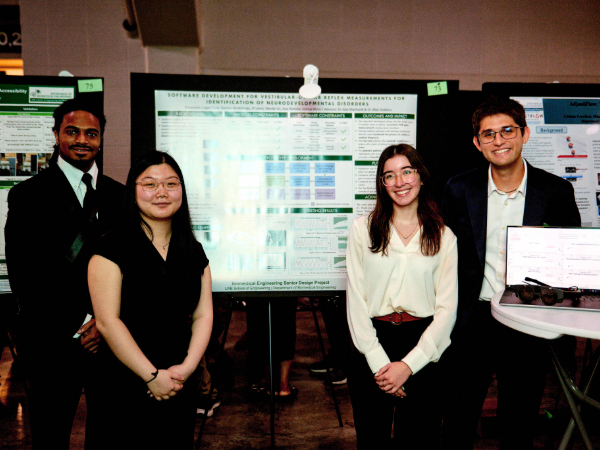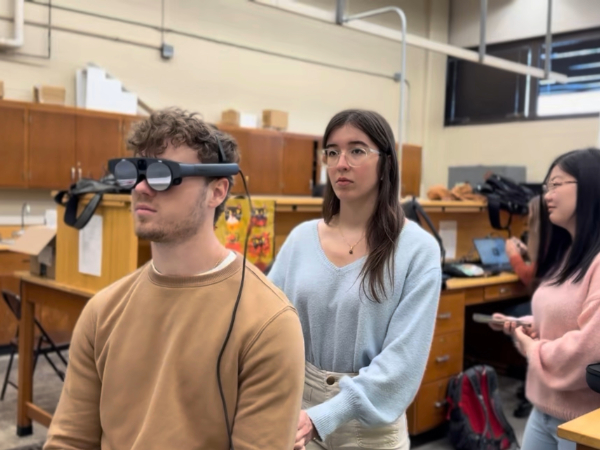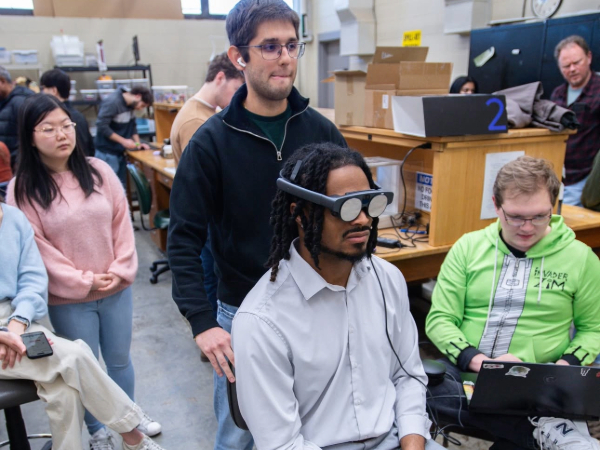 What if a virtual reality headset could help detect rare forms of autism? That question led six biomedical engineering seniors at UAB to design a groundbreaking diagnostic tool and win first place among more than 60 teams at the university’s Senior Design Expo.
What if a virtual reality headset could help detect rare forms of autism? That question led six biomedical engineering seniors at UAB to design a groundbreaking diagnostic tool and win first place among more than 60 teams at the university’s Senior Design Expo.
The student team, Logan Cook, Wendy Lin, J.D. Lewis, José Ramirez, Daniela De Nobrega, and Joshua Wynn didn’t just impress judges with sleek software or a polished presentation. Their innovation could someday cut months, even years, off the time it takes for children to be diagnosed with neurodevelopmental disorders such as autism spectrum disorder (ASD).
The project was born out of both technical ingenuity and a deep desire to improve lives, something the team hopes will resonate beyond competition judges.
“The idea for this project arose a year ago when I read an interesting article about autism that connects a single gene to a specific phenotype,” said Allan Dobbins, Ph.D., associate professor in the Department of Biomedical Engineering, who served as the team’s mentor. “I offered the idea of building virtual reality glasses to develop a biomarker for this form of autism. This talented group of six seniors took up the challenge and did an outstanding job getting a working prototype going. It is what makes working intensively with students so rewarding.”
Now, the team is taking their idea national as competitors in the DEBUT Challenge, a prestigious biomedical design competition sponsored by the National Institute of Biomedical Imaging and Bioengineering and VentureWell.
Their project uses virtual reality to track eye movements during controlled head motions. This approach evaluates something called vestibulo-ocular reflex (VOR), a mechanism that helps keep vision steady while we move our heads. Abnormalities in the VOR have been linked to certain ASD subtypes, particularly those involving mutations in the SCN2A gene.
 While more than 100 genes have been associated with ASD, most cases still lack a clear biological signature. But SCN2A is different. It affects a specific sodium channel in the brain, which, when altered, impacts how the eyes and brain work together to interpret motion. That’s where the team’s headset comes in.
While more than 100 genes have been associated with ASD, most cases still lack a clear biological signature. But SCN2A is different. It affects a specific sodium channel in the brain, which, when altered, impacts how the eyes and brain work together to interpret motion. That’s where the team’s headset comes in.
The students, under the mentorship of Dobbins and in collaboration with Cassandra Newsom, Psy.D., associate professor in the Department of Neurobiology and director of the Translational Research Core in Autism and Neurodevelopment of Civitan International Research Center, created a system that captures and analyzes eye movement data in real-time, aiming to reveal patterns that could flag neurodevelopmental disorders earlier and more objectively, as well as monitor treatment outcomes or help monitor response to treatments.
The promise of the project has already garnered institutional support. Dobbins and Newsom recently received a $40,000 Pilot Grant Award from the UAB Vision Science Research Center (VSRC) to further validate the VR-based VOR assessment tool for children with rare neurodevelopmental disorders. The award, which also includes matching support from the Civitan International Research Center, will help propel the project beyond the prototype phase.
Daniela De Nobrega, one of the six team members who worked on the project, said the group aimed to create a tool that balances innovation with real-world accessibility. “With healthcare costs rising and access to specialists limited in many areas, we believe medical solutions should prioritize simplicity and affordability,” she said. “Our project aims to help clinicians and researchers with tools that are practical and scalable, bringing innovation to those who need it most.”
 If successful, their work could make a real difference for families navigating complex, often delayed diagnostic journeys. For many, getting answers can take years of evaluations and travel to specialists. A portable, fast, and accessible screening tool could change that story.
If successful, their work could make a real difference for families navigating complex, often delayed diagnostic journeys. For many, getting answers can take years of evaluations and travel to specialists. A portable, fast, and accessible screening tool could change that story.
As the DEBUT Challenge continues this summer, the team is fine-tuning their system and hoping their work will go even further, from the classroom and lab to clinics and communities.